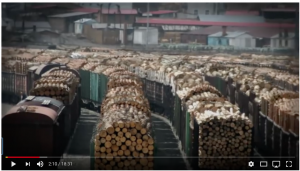How to not end up like the villain in a children’s story
There are many children’s stories, like The Lorax, Fern Gully, and Captain Planet that could give you the impression that any form of resource harvesting is evil. However, like many global, economic, and scientific issues, forestry resource management is fairly complex. When done right, it can improve the health of the forest and prevent mass destruction like disease and wildfire. When done incorrectly well… Captain Planet might prove useful after all.

Hexxus was a source of many nightmares for millennial children
In North America, timber harvest is highly regulated. Forests are harvested every year in sections. When a section is designated for harvest, a team of people mark only the trees in that section that have a large enough diameter. Those trees are harvested while younger and smaller trees are left alone.
When the harvest is over, the smaller trees remain untouched—and they have more room and light to grow. For every cubic foot of tree harvested, an average of 1.6 cubic feet are planted. That section is then left alone for the next 25-60 years and a new section is designated the following year.
According to a report done by the Food and Agriculture Organization, the volume of forest growth in the US in 1997 was 380 percent greater than it was in 1920. Breathe easy, the regulations are working.
A case for proper forest management
Like all living things, trees eventually die on their own, and when they do, they fall over. When they fall, they crush, cover, or kill anything growing underneath them or inside them. Fire becomes an issue because a dead tree is a dry tree, making it more susceptible to fire.
Those raging wild fires you hear about every year? They are aided by thousands of dead, poorly managed trees, and are usually started by something like a lighting strike, or geniuses at a bachelor party. Those fires kill everything in their path—including healthy living trees. Forests that are managed and maintained properly are less susceptible to the wildfires and diseases of a neglected forest.
Sourcing your wood products from North American forests incentives further maintenance and management of those forests. It’s economics 101; companies that specialize in wood products don’t want to run out of wood. If the demand for quality, responsible products is there, then people will try to meet it.
Diseased trees and forest fires aren’t good for anybody.
Responsible sourcing – not everybody does it
Essentially, if the wood product you are purchasing was originally sourced in the US or Canada, chances are overwhelmingly good that it was done so responsibly. That said, just because wood has been imported doesn’t necessarily mean that it was sourced irresponsibly. The difficult part with imported lumber is it is much harder to trace its true original source.
In the last few years, there have been a few cases where large American companies have been cited for importing and selling wood that was not properly documented and, in some cases, illegally sourced.
One high profile case in the flooring industry saw a company buying wood that was clear cut in an endangered tiger habitat in the Russian Far East (a protected area for the Siberian Tiger, of which there are only about 300 left). The wood was then smuggled into China where it was essentially laundered, milled into flooring and sold to unknowing American consumers under the guise that the wood was of Chinese origin, not Russian.

Watch the full story here
Not cool… Or legal.
In 2015, Lumber Liquidators pled guilty to a felony Lacey Act Violation and four misdemeanors after an investigation by the US Justice Department found several instances of corruption in the supply chain (https://www.justice.gov/opa/pr/lumber-liquidators-inc-sentenced-illegal-importation-hardwood-and-related-environmental). It is unknown if the company knew it was breaking the law, but that’s a scary thought because if the largest flooring retailer in the North America doesn’t know where the imported wood it sells is coming from, how are average consumers supposed to know?
So what should you do?
Buy authentic hardwood sourced in the US or Canada. Purchasing hardwood products produced in the US and Canada rewards, encourages, and supports responsible forest management. At Revel Woods, we understand that, which is why every floor we sell has been sourced, manufactured, and milled in North America.
At Revel Woods, we chose to offer only products sourced in the United States and Canada. Our industry connections allow us to buy from all over the world (and we get calls from people offering to supply us all the time), and while those sources are probably totally legit, we only want to offer you something we can stand behind 100%.